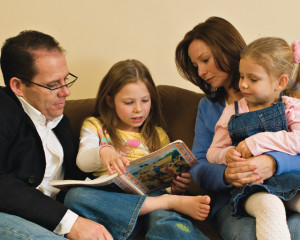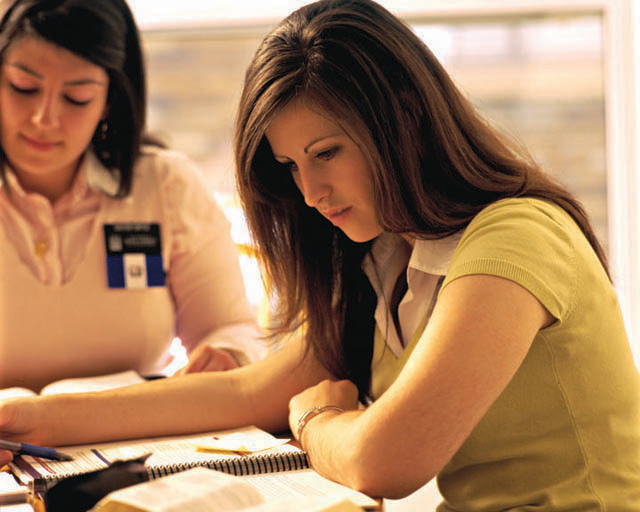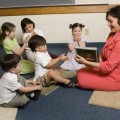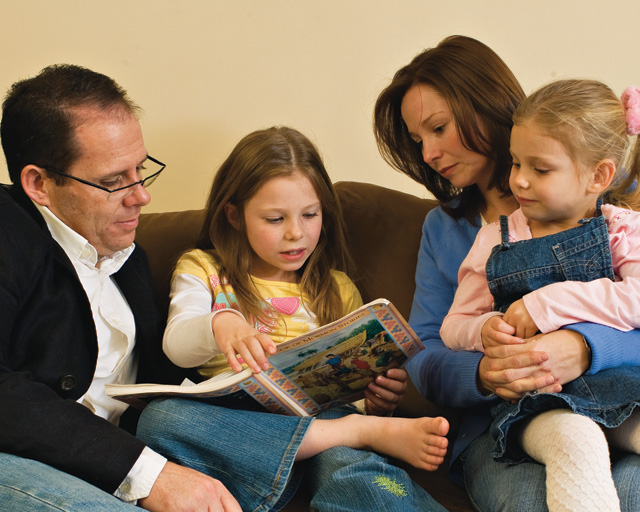Curious about what is inside a Mormon meetinghouse? Visitors are always welcome in these smaller buildings designed for regular worship and weekday activities. However, you can also tour a building virtually through a new feature on the Mormon’s official website.
Start the Mormon Meetinghouse tour. In the previous article, we explored the foyer and chapel and learned what went on during a service.
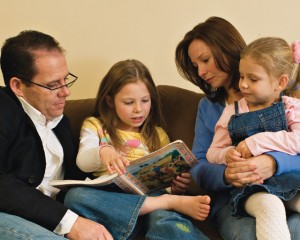 Today, we’ll explore two special classrooms: The Relief Society and the Primary Rooms.
Today, we’ll explore two special classrooms: The Relief Society and the Primary Rooms.
Look below the tour to see the map. The Relief Society room is in the top right hand corner of the map. This room is especially for women and is therefore, usually the prettiest room. It normally has nice curtains, attractive paintings, tablecloths, flowers, and other feminine touches. They are usually the only classroom provided with padded seats.
Mormons meet for three hours each Sunday. The main worship service lasts an hour and ten minutes. Following this, the families go in various directions, with adults and teens having two classes to attend, and children attending their own program. Relief Society is normally held the last hour and is only for the women. The organization was founded in 1842, and centers around providing service to others. On Sundays, the women meet for a class that is especially tailored to the particular lives and needs of women. Some weeks they study the same topic as the men, but with a feminine focus if there is one. Other weeks, they study unique topics. Lessons are drawn from teachings of past church leaders, talks given in semi-annual conferences from current church leaders at the international level, and topics of special interest to women.
During the week, each Relief Society may choose to have special clubs, classes, or meetings to help women perform service, learn new skills, and pursue hobbies and friendships. Examples might include a mom and tots group, a blogging club, a humanitarian aid group, lessons in car and home repair, or craft programs. The choices are as diverse as the women themselves, and vary based on the interests and needs of each group.
A unique feature of the Relief Society is the visiting teaching program. Women, working with an assigned partner, are given three or four other women to visit monthly. They come to the home with a brief spiritual message to discuss, and they also work to build a friendship with these women. They are charged with watching for needs the church can fulfill and are the first person a woman calls when she needs help. A visiting teacher will then either provide the service, or help to find someone who can. For instance, a visiting teacher might bring in a meal when the sister (the Mormon form of address for adult women) is ill, watch her children when she has a doctor’s appointment, or alert leaders the family has nothing to eat. It is reassuring to women to know there is someone they can call when they need help or just a friend.
The Relief Society also operates a literacy program that is tailored to whatever needs the congregation might have. Some groups use a church program to teach reading. Others teach English to immigrants, tutor inner-city children, or help people learn to write their personal and family histories.
Now go back to the map and click on the Primary room, found in the bottom right hand corner. This room belongs to the children of the church, ages three to twelve. In most wards (congregations) the children are divided into two groups, Junior Primary and Senior Primary, with age eight being the dividing line. They will meet in the Primary room all together for opening exercises. During this time, they have a prayer, songs, a scripture and a talk given by a child. Even a three-year-old might stand at the pulpit on a step that allows him to reach the microphone, and give a two and a half minute talk on a gospel principle with the help of a parent. This allows children to learn from their peers, and also helps the children learn poise, confidence and public speaking skills, while encouraging him to share his thoughts on an aspect of his faith.
Following this, most Primaries send the older children off to age-divided classes. Their classrooms are small and usually contain a chalkboard, bulletin board, and chairs sized to the students. The teacher prepares a lesson from a manual that can be read online. Read the lesson manuals used to teach Mormon children.
These older children are called Valiants. They have been baptized and are learning to be valiant in keeping the baptismal covenants (promises) they made to God. Mormon children are baptized at age eight. The lessons are taught through the scriptures, and they follow the same four year plan as their parents and teenage siblings, allowing families to discuss together the scripture stories learned. The children spend two years learning the Bible, one learning the Book of Mormon, and one learning church history and the Doctrine and Covenants. This last book is a collection of revelations received in modern times.
After their lesson, the children return to the Primary room for Sharing Time. The younger children, who were already having sharing time, go to their own classes. The younger children are called CTRs, which stands for Choose the Right. They are preparing to be baptized and are learning enough about their religion to make a wise choice and are also learning to become like Jesus. In their lessons, they follow a two year program. When it is repeated, they are more mature and can handle the same lesson taught at a higher level. They spend one year on the Bible. The second year covers the Book of Mormon and the Doctrine and Covenants.
Also included in Junior Primary are the Sunbeams, who are three at the start of the year. Their lesson manual is used for only one year and contains stories from all the scriptures taught in simple ways.
In Sharing Time, the children receive a fifteen minute lesson from a member of the Primary Presidency, a group of three women who run the program. There is a theme for the entire year, such as “I Am a Child of God” or “I’m Trying to Be Like Jesus.” Each month, they study an aspect of the theme during Sharing Time. They also have fifteen minutes of singing with a music leader. Much of this music is focused around the theme as well. Near the end of the year, the children do a program for the entire congregation, taking over the regular service to sing and to teach the adults what they’ve learned.
The Primary room has chairs in a variety of sizes placed in rows. Children sit with their own classes and teachers. It usually includes a piano and pictures of Jesus with children. There is a chalkboard and decorated bulletin boards.
The Primary oversees a nursery, as well. This is for children who are eighteen months old to age three. If they are three years old January 1, they graduate to the Sunbeam class. This is not just child-care. It is a true class. The children have a lesson manual with simple lessons that teach them about God and Jesus in easy to understand ways. They generally have about ten minutes of lesson time, a fifteen minute singing time, crafts, group play, stories, and a play time. At least two teachers are present at all times.
Senior nursery children have weekday programs. The boys participate in Cub Scouts and the girls have a similar program called Activity Days.
In the next article, we’ll learn about the Youth program for teenagers, and about the cultural hall.
About Terrie Lynn Bittner
The late Terrie Lynn Bittner—beloved wife, mother, grandmother, and friend—was the author of two homeschooling books and numerous articles, including several that appeared in Latter-day Saint magazines. She became a member of the Church at the age of 17 and began sharing her faith online in 1992.

